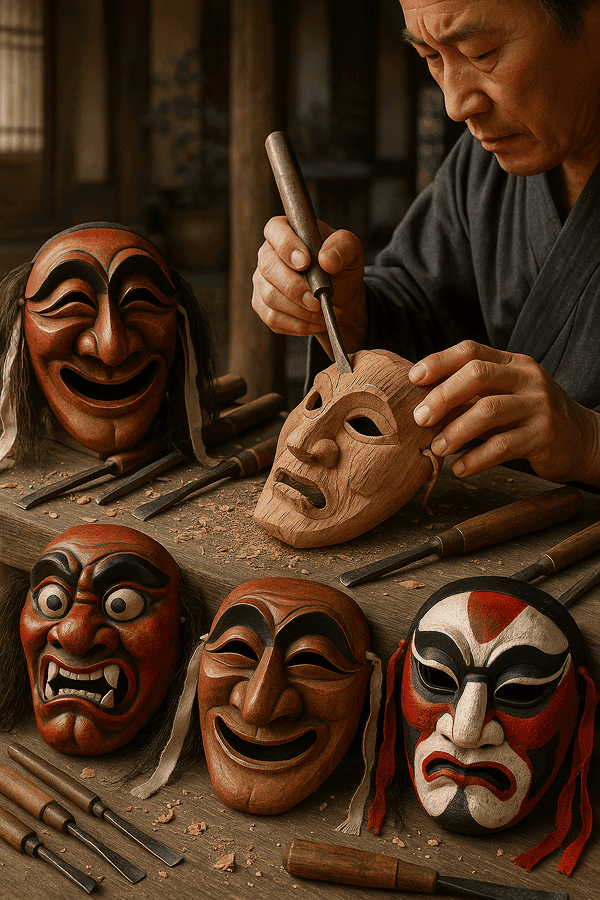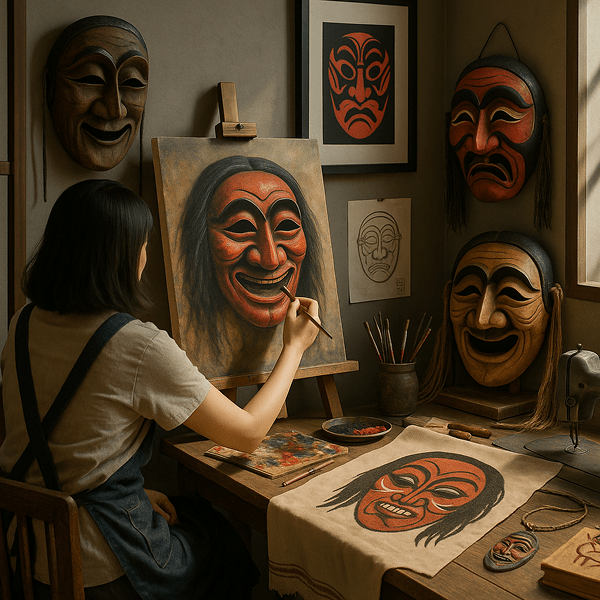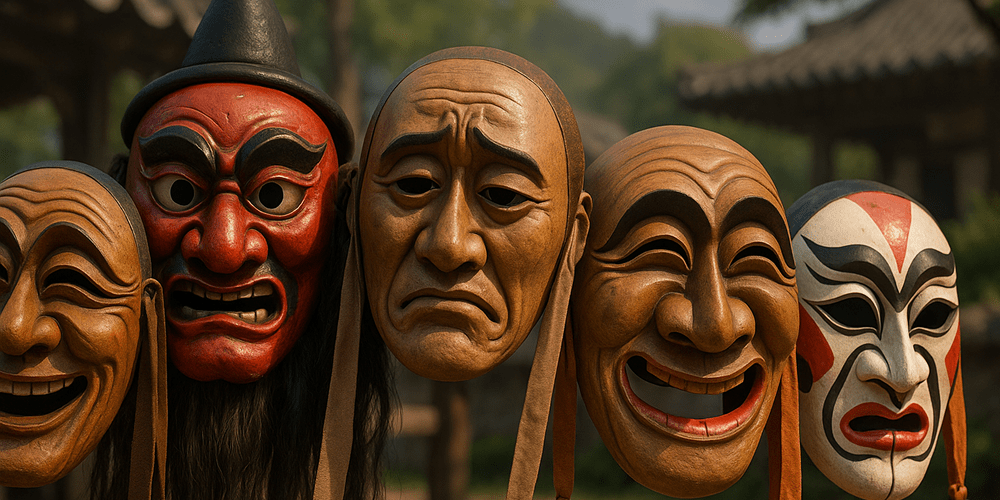Korean shamanic masks, known as “tal” (탈) or “kut tal” (굿탈), are deeply rooted spiritual artifacts that have played a central role in Korea’s ritual and folk traditions for centuries. Instantly recognizable for their expressive features — ranging from exaggerated grins and contorted grimaces to demon-like visages — these masks are crafted to embody a variety of spirits, deities, and ancestral figures. Characteristically, Korean shamanic masks are lightweight, often painted in vivid colors, and feature holes or slits for the eyes and mouth to enable both visibility and vocal expression during ceremonies. While shamanic masks are found throughout the Korean Peninsula, they are especially associated with regions such as Hahoe, Andong, and the southern provinces. The tradition of mask-making and ritual use dates back to at least the Three Kingdoms period (c. 57 BCE–668 CE) and continues to be celebrated in contemporary Korean culture.
Historical Origins of Korean Shamanic Masks
The origins of Korean shamanic masks are ancient and intertwined with the development of Korean spiritual practices and indigenous animism. The term “tal” itself means “mask” in Korean, though it has also come to signify “face” or “spirit.” Early forms of shamanic masks likely emerged from prehistoric rites intended to ward off evil spirits, appease natural forces, and ensure communal well-being. Archaeological finds from the Silla and Goryeo periods reveal the use of wooden and clay masks in both ritual and performance contexts. As Korea’s religious landscape evolved — with the introduction of Buddhism and Confucianism — shamanic mask traditions persisted, adapting to new social realities and artistic influences. The design and function of masks have evolved over time, shifting from simple, abstract forms to highly detailed and symbolic creations. Notably, historic texts such as the “Samguk Sagi” and temple murals document the use of masks in both exorcism rites and early forms of mask theater. Among the most renowned are Sandae Masks, which, while primarily associated with traditional Korean theater, share roots and motifs with shamanic mask-making.
Cultural Significance and Symbolism of Korean Shamanic Masks
Shamanic masks hold powerful symbolic meaning in Korean culture. They are seen as vessels for spiritual transformation, allowing the wearer — often a mudang (shaman) or ritual participant — to channel the presence of gods, spirits, or ancestors. Common motifs include human faces with exaggerated expressions, animal features such as tigers or birds, and supernatural beings associated with protection, fertility, or retribution. Colors are deeply symbolic: red wards off evil, black signals power, and white denotes purity or mourning. Many myths and legends surround the creation and use of masks, including stories of masks carved under divine inspiration or masks believed to possess their own spirits. Socially, the use of shamanic masks reinforces community bonds, marks important life events, and transmits traditional values. The mask’s role in kut (shamanic ritual) is to mediate between worlds, offering healing, guidance, and blessing.
Materials and Craft Techniques of Korean Shamanic Masks
Traditional Korean shamanic masks are typically made from lightweight woods such as alder, willow, or pine — chosen for their spiritual purity and ease of carving. In some regions, masks are also fashioned from gourds, paper-mâché, or layered cloth. The crafting process begins with the selection and cleansing of materials, often accompanied by prayers or offerings. Artisans (taljang) carve the basic form using knives and chisels, then refine the features and add expressive details. The surface is painted with natural pigments — reds, blacks, whites, and sometimes gold — using fine brushes. Decorations such as horsehair, fabric, or metal ornaments may be added for dramatic effect. Regional differences abound: masks from Hahoe are famed for their asymmetrical, almost playful features, while those from Tongyeong are more stylized and angular. Each mask is unique, reflecting both the artisan’s creativity and the mask’s intended ritual function.

Functions and Ritual Use of Korean Shamanic Masks
The core function of Korean shamanic masks is ritual and ceremonial. They are worn during kut rituals, where shamans invoke spirits, deliver prophecies, or perform healing acts. Masks enable the transformation of the wearer into gods, ancestors, or mythic beings, allowing direct communication between human and spiritual realms. In addition to religious ceremonies, masks are central to traditional Korean mask dances (talchum), which blend shamanic elements with theatrical storytelling, satire, and social commentary. These performances, often held during village festivals, serve both entertainment and didactic purposes — critiquing social hierarchies, celebrating fertility, and reinforcing communal ties. Over time, the use of shamanic masks has adapted to changing cultural contexts; today, they are featured in cultural festivals, museum exhibitions, and even contemporary art installations, ensuring their continued relevance in Korean society.
Regional Variations in Korean Shamanic Mask Traditions
Regional diversity is a hallmark of Korean shamanic mask traditions. The Hahoe masks of Andong are perhaps the most famous, celebrated for their lively expressions and association with UNESCO-listed mask dances. In the south, the Tongyeong and Goseong regions produce masks with sharper lines and more abstract features. Each region incorporates local myths, dialects, and rituals into the design and use of masks. For example, the Bongsan Talchum masks are distinct for their vibrant colors and grotesque humor. While sharing similarities with shamanic masks from Japan or China — such as the use of animal motifs and exorcistic functions — Korean masks are unique in their blend of satire, spirituality, and social commentary. Their expressive range and craftsmanship set them apart within the broader East Asian tradition.
Famous Examples and Museum Collections of Korean Shamanic Masks
Some of the most renowned Korean shamanic masks are preserved in national and regional museums. The Hahoe Mask Museum in Andong houses a comprehensive collection, including original masks used in historic rituals and performances. The National Museum of Korea (Seoul) and the National Folk Museum of Korea display rare masks from the Silla, Goryeo, and Joseon periods, as well as contemporary works by master carvers. Important archaeological finds — such as ancient wooden masks from temple sites — offer insight into the evolution of mask-making. Private collections, both in Korea and internationally, also play a role in preserving and sharing these cultural treasures. For digital access and expert analysis, resources like toddmasks.com provide virtual galleries and educational content.
Influence of Korean Shamanic Masks on Art and Culture
The influence of Korean shamanic masks extends far beyond ritual, shaping visual arts, literature, theater, and even fashion. Their bold features and dramatic forms have inspired painters, sculptors, and stage designers — both within Korea and globally. Mask motifs appear in Korean cinema, novels, and music, often evoking themes of transformation, hidden identity, and the supernatural. In contemporary design, elements of shamanic masks are found in jewelry, textiles, and graphic art, reflecting a renewed interest in traditional aesthetics. The preservation and reinterpretation of mask culture play a vital role in maintaining Korea’s rich artistic heritage, ensuring that new generations remain connected to their roots.

Modern Status and Preservation of Korean Shamanic Mask Traditions
Today, the tradition of Korean shamanic masks is actively preserved and revitalized by master artisans, cultural organizations, and academic institutions. Artisans continue to make masks using ancient techniques, often training apprentices in family or community workshops. Government-backed festivals, competitions, and exhibitions celebrate mask culture and encourage public participation. Innovations abound, with artists experimenting with new materials and digital media, while maintaining respect for traditional forms and meanings. Educational programs, workshops, and masterclasses — some highlighted on toddmasks.com — help transmit knowledge to younger generations and international audiences. Through these efforts, the legacy of Korean shamanic masks remains a living, dynamic part of Korean identity.
Collecting and Acquiring Korean Shamanic Masks
The market for Korean shamanic masks is robust, with authentic pieces available through artisan studios, folk art markets, and reputable galleries. The value of a mask depends on factors such as age, craftsmanship, provenance, and historical significance. Collectors are encouraged to seek expert advice, verify authenticity, and prioritize ethical sources that support local artisans and cultural preservation. High-quality replicas and contemporary creations are also in demand, offering accessible ways to engage with mask culture. Resources like toddmasks.com provide guidance on collecting, authenticity, and the ethical considerations involved in acquiring cultural artifacts. Responsible collecting not only enriches personal collections but also helps sustain the artisans and traditions that keep this art form alive.
